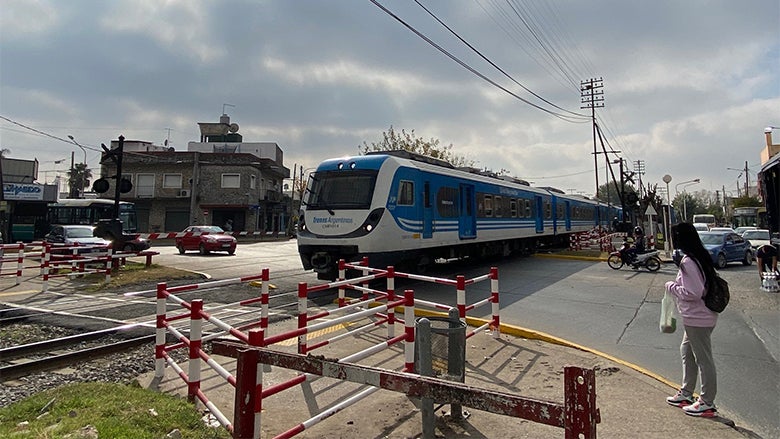 Train passing through a level crossing
Train passing through a level crossing
If you ever had the chance to visit beautiful Buenos Aires, you probably used its large and far-reaching public transport system, which includes 800 km of suburban rail tracks and one of the world’s most extensive bus networks, on which millions of people travel daily.
Despite this, urban mobility in Buenos Aires is changing gradually as travelers move toward the use of private cars as a result of underinvestment in public transport in contrast with increased road investments and of growing urban sprawl based on high-income gated communities and low-income informal settlements.
These trends were aggravated by the COVID-19 pandemic, which caused a temporary drastic drop in demand for public transport which has not fully recovered, as opposed to motorized traffic which is back to pre-pandemic levels. This increasing motorization is particularly affecting the poor, more reliant on public transport, and more vulnerable to disruptions in services caused by climate change impacts.
To address this challenge, the World Bank is working with the government of Argentina to modernize Buenos Aires’ suburban passenger rail system through track upgrades and extensions, station improvements, electrification, and transformation of level crossings.
In April 2021, a US$347 million loan was approved for the renovation of the Mitre Line, a commuter rail line connecting Retiro station, in the central business district, to the suburbs in the north and west of the Greater Buenos Aires. Another US$600 million loan to modernize and electrify the Belgrano Sur Line was recently approved in May 2022. This line connects the City of Buenos Aires with the southern part of its metropolitan area using diesel trains, providing accessibility to the most vulnerable and low-income areas of Greater Buenos Aires.
Holistic approach
In the design of these operations, we followed a holistic and integrated approach, involving aspects such as climate resilience, road safety, multimodality, gender equality, universal accessibility, sustainability, and efficiency.
First, the rail modernization projects will reduce transport greenhouse gas (GHG) emissions as a result of modal shift to rail and of the electrification of rail traction, reducing the reliance on diesel fuel and helping achieve Argentina’s nationally determined contributions (NDCs) under the Paris Climate Agreement.
The adaptation of railway infrastructure is also a priority, as climate change will increase the service disruptions caused by natural hazards (increased rainfall, flooding, heatwaves). In this sense, the Global Facility for Disaster Reduction and Recovery provided grant funds to study and identify measures to improve climate resilience (new design standards, revised maintenance, contingency programming to mitigate damages, losses, and disruptions, etc.), which will inform the preparation of executive designs for track renovation and new stations.
Second, level crossings affect rail service and pose a significant road safety risk. In fact, only in the City of Buenos Aires, 13 fatalities were registered in the Belgrano Sur line between 2009 and 2018. Vehicular level crossings in the City of Buenos Aires will be transformed into underpasses, with designs avoiding the separation or enclosing of spaces in communities where safety is a concern. Actions to upgrade stations and their surroundings will be informed by road safety audits to understand the highest risk. The projects also foster multimodality by introducing bicycle parking facilities at stations and contribute to urban integration, like the case of Barrio Padre Carlos Mugica which will benefit from a new station (Facultad de Derecho).
Third, both projects also aim to advance gender equality. Women rely more heavily on informal and public transport (50% versus 37%), 72% of women reported feeling unsafe when commuting (14 points more than men), and leadership positions in the transport sector are still dominated by men (71%).
With the goal of contributing to closing the gender gaps in the railway sector, we partnered with Safetipin to conduct “gender audits” of stations and their surroundings and to propose measures and design standards that improve safety, especially for women and the LGBTQ community.
The national railway infrastructure manager (ADIF) and operator (SOFSE) received training on Safetipin’s methodology and on best practices to generate safe spaces. Both projects will also provide universal accessibility by eliminating barriers affecting people with disabilities, which took part in the in-depth community consultation process carried out.
Finally, based on consultations with users of the railway system, the design of these projects put the focus on improving the reliability, frequency, and safety of commuter trains.
We are working closely with ADIF and SOFSE to create the conditions for enabling efficiency improvements through a predictive maintenance system and the monitoring of Key Performance Indicators (KPI). This is expected to improve punctuality and reliability. KPIs will also help optimize occupancy levels to avoid crowding and maximize the comfort and safety of passengers.
The increased efficiency will result in operational cost savings that would allow focusing on capital investments that will improve the infrastructure and rail service.
In this way, we are contributing to a greener, safer, and more inclusive public transportation system in Greater Buenos Aires so that its inhabitants can access employment and education opportunities, and social services.
We also hope that the next time you visit Buenos Aires you will have the chance to move around using its renovated railway system.




Join the Conversation